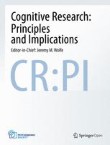Cognitive Research: Principles and Implications is affiliated with The Psychonomic Society
Individual differences in the detection, matching and memory of faces
Previous research has explored relationships between individual performance in the detection, matching and memory of faces, but under limiting conditions. The current study sought to extend previous findings w...
